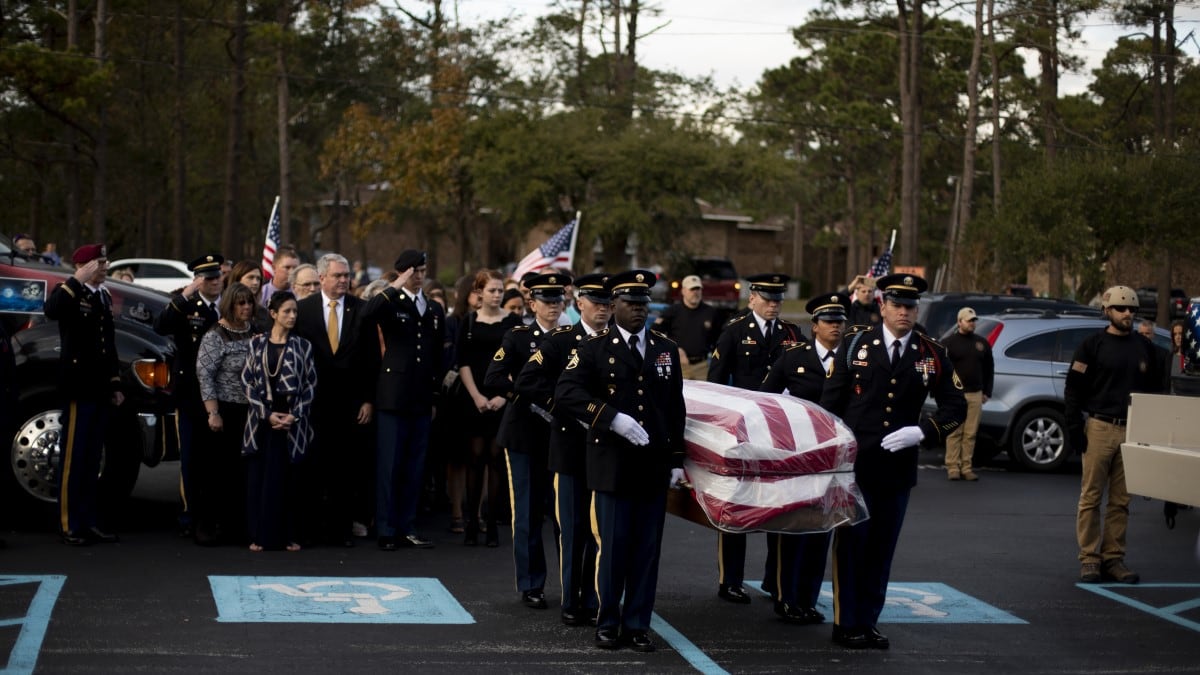An investigation into the 2018 death of an Army EOD tech in Helmand province, Afghanistan, found that his unit faced equipping and funding issues prior to deployment, and the company command team had to go to great lengths to resolve those problems before arriving downrange.
The investigation also found that U.S. troops out of Camp Dwyer had patrolled in the vicinity of a fatal Oct. 4, 2018 bomb attack 19 times in the three months before the mission, giving the Taliban an idea of where the Americans would eventually drive their armored vehicles. The investigation was obtained by Army Times through a Freedom of Information Act request.
Though the soldiers had been tracing their patrol routes to ensure they didn’t revisit the same passages, the investigation recommended they expand that practice to ensure they’re not setting patterns in the area.
Sgt. James Slape died while clearing a safe path around a disabled MaxxPro vehicle that had hit an improvised explosive device on a ridge earlier in the day. There was a group of stranded U.S. troops still inside when Slape arrived.
The 23-year-old EOD tech used a CEIA v2 counter-IED device while sweeping around the vehicle, but the “loose soil with large rocks underneath can reduce the effectiveness” of the equipment, an investigating officer wrote. The soldiers likely encountered several pressure-plate IEDs and small anti-personnel mines in what award citations later described as a minefield.
Before they deployed, the North Carolina National Guard’s 430th Ordnance Company faced some resource challenges, which “stemmed from funding constraints within the National Guard and a time-consuming request process,” the investigator wrote.
During a mission readiness exercise at Camp Blanding, Florida, the Guardsmen used training aids from previous exercises and had to personally purchase their own materials, including wood, wire and electrical tape, to build mock IEDs.
“Contractor support to build training aids was not provided,” the investigator wrote. “It is unclear if the funding was denied or if the request for funds was not approved in time.”
The investigator added, however, that the deploying troops’ command team “ensured the company was properly trained despite the various resource constraints they encountered,” citing multiple weeks-long courses the unit attended.

There were other issues stateside, though. The 430th’s equipment was outdated, the investigator wrote. The unit was approved to purchase the most current counter-IED devices available as they prepared for deployment, but that was under their Title 32 authorities. Once the company was activated for deployment, funding then resided under Title 10 authorities.
In a Kafkaesque reversal, the new authorities voided the unit’s previous request. But with support from Naval EOD and in-theater equipment stocks, the 430th was able to obtain the latest counter-IED equipment, including Minehound VMR2s and CEIA v2s, upon arrival to Afghanistan, according to the investigation.
None of those issues were cited as having played a role in Slape’s death.
The EOD tech was part of a quick reaction force dispatched to the ridge miles from Camp Dwyer after a 20-ton MaxxPro on patrol struck an IED. That patrol, which had been trying to intercept insurgent radio traffic, could not self-recover the vehicle, activating Slape’s unit just before 10 a.m.
The troops in the damaged MaxxPro were told to stay in place until the area around their vehicle was cleared — Slape’s job.

The task was to clear an evacuation path for those stuck inside the damaged vehicle, and Slape was considered a subject matter expert on handheld counter-IED devices. He had conducted 28 patrols during the deployment and taught more than 300 personnel how to use counter-IED devices.
During his slow and deliberate clearance, Slape struck what was suspected to have been a small anti-personnel mine, due to the lack of a post-blast crater.
Immediately after the detonation, several soldiers rushed through uncleared terrain to recover the gravely wounded EOD tech and began placing IV lines, tourniquets and a needle chest decompression into him. He was medically evacuated by helicopter to Camp Dwyer only 32 minutes after the blast, but was declared deceased at the Role II facility there roughly an hour later.
There was no physical evidence left from the IED blasts to determine the exact types of devices, “nor was there any evidence of command wire,” the investigator wrote. Additionally, “there is no way to determine when the IEDs were inserted.”
Because the soldiers had jammers on to mitigate radio-controlled IED detonations, Slape’s comrades at the 430th concluded that the first bomb encountered was likely a low-metallic signature pressure-plate located directly on top of a 25-pound explosive charge.
“When pressure plates are placed directly on the explosives (compared to an offset placement), there is minimal evidence available to collect after an explosion,” the investigator wrote.
Kyle Rempfer was an editor and reporter who has covered combat operations, criminal cases, foreign military assistance and training accidents. Before entering journalism, Kyle served in U.S. Air Force Special Tactics and deployed in 2014 to Paktika Province, Afghanistan, and Baghdad, Iraq.




